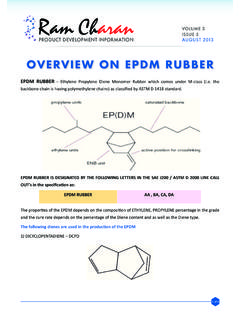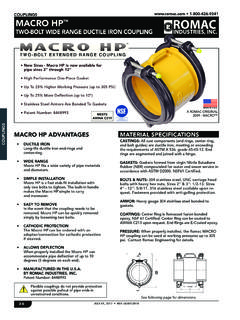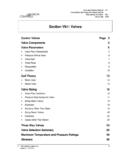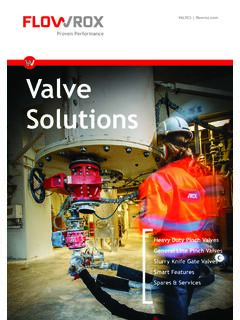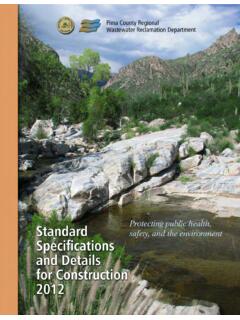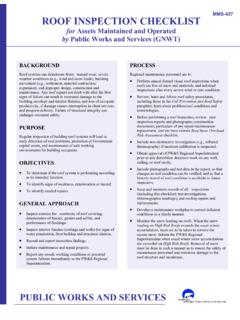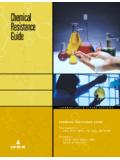Transcription of General Properties of Elastomers
1 1 300 Martinel Dr. | Kent, OH 44240 | Phone: (877) 302-0423 | Fax: (330) 673-3235 | CCuussttoomm && SSttaannddaarrdd RRuubbbbeerr EExxttrruussiioonnss GGEENNEERRAALL PPRROOPPEERRTTIIEESS OOFF EELLAASSTTOOMMEERRSS ELASTOMER PAGE Butyl 2 EPDM ( ethylene - propylene - diene Modified) 3 Natural Rubber 4 Neoprene 5 Nitrile (Buna-N) 6 Polyisoprene 7 SBR (Styrene Butadiene) 8 Silicone 9 Summary Chart 10 2 300 Martinel Dr. | Kent, OH 44240 | Phone: (877) 302-0423 | Fax: (330) 673-3235 | CCuussttoomm && SSttaannddaarrdd RRuubbbbeerr EExxttrruussiioonnss BBUUTTYYLL General DESCRIPTION: Butyl is produced by copolymerizing isobutylene with small amounts of isoprene (typically 98% polyisobutylene and 2% isoprene).
2 Butyl rubber was first commercialized in the early 1940s. With excellent gas impermeability and air retention along with good flex Properties , the first major application of butyl rubber was tire inner tubes. Butyl rubber has a typical service temperature range between 75 F and +250 F. ADVANTAGES: Butyl rubber has exceptional resistance to gas and moisture (water and steam) permeation. Butyl rubber also has excellent resistance to oxygenated solvents (ketones and alcohols), alkalis, flexing, and abrasion.
3 Butyl is capable of providing high energy absorption (damping) and thus has excellent electrical isolation performance. Butyl has good resistance to sunlight, ozone, heat aging, animal and vegetable oils, oxidizing chemicals, silicone fluids and greases, ammonia, hydrazine, and phosphate ester type hydraulic fluids ( , Skydol, Fyrqeul, Pydraul). The molecular structure of butyl rubber can be oriented to resist stress. Mechanical Properties are retained over a relatively wide stiffness range since reinforcement is not required for good tensile and tear strength.
4 LIMITATIONS: Butyl rubber is difficult to handle during manufacturing because of its tendency to trap air, blister, and creep. Cold flow characteristics and flame resistance are poor. Butyl is not recommended for use with petroleum oils, fluids, or solvents. Butyl has poor resistance to aromatic hydrocarbons ( , Benzol, Toloul), aliphatic hydrocarbons ( , kerosene, turpentine), coal, tar, and diester-based lubricants. Cold weather Properties for butyl rubber are fair. COMMON APPLICATIONS: Butyl s excellent impermeability to gas makes it very useful in seals for vacuum applications.
5 Butyl s gas impermeability coupled with its air retention capabilities make butyl popular for use in tire inner liners and inner tubes. Butyl is also used in hydraulics applications where synthetic fluids are used. 3 300 Martinel Dr. | Kent, OH 44240 | Phone: (877) 302-0423 | Fax: (330) 673-3235 | CCuussttoomm && SSttaannddaarrdd RRuubbbbeerr EExxttrruussiioonnss EEPPDDMM ((EEtthhyylleennee--PPrrooppyylleennee-- DDiieennee MMooddiiffiieedd)) General DESCRIPTION: There are two basic types of EP rubber available in today's market EP and EPDM.
6 EP is a copolymer of ethylene and propylene , while EPDM is a terpolymer combining ethylene , propylene and a diene monomer . EP uses a peroxide cure system. EPDM uses a sulfur cure system. EPDM has a typical service temperature range between 65 F and +300 F. ADVANTAGES: EPDM exhibits exceptionally good resistance to weather aging, ozone, UV exposure, water, heat, phosphate ester base hydraulic fluids (Skydrol, Fyrquel, Pydraul), dilute acids, electrical insulation. EPDM has good to very good resistance to steam, oxygenated solvents (acetone, methyl, ethyl ketone and other ketones), animal and vegetable oils, alkalis, brake fluids, and compression set.
7 EPDM s dynamic and mechanical Properties are, in General , between natural rubber and SBR. LIMITATIONS: EPDM is not recommended for use with petroleum oils, fluids, or solvents because significant swelling would result. EPDM has poor resistance to aromatic hydrocarbons ( , Benzol, Toloul) and aliphatic hydrocarbons ( , kerosene, turpentine). COMMON APPLICATIONS: EPDM is one of the most widely used synthetic rubbers in many static and dynamic applications. EPDM is used extensively in outdoor applications where weather and water resistance is required.
8 It can be found in several industries ranging from automotive to HVAC. Gaskets, bumpers, auto parts, auto brake systems, electrical installation, dust covers, weather stripping and conveyor belts are just of the many products that use EPDM. 4 300 Martinel Dr. | Kent, OH 44240 | Phone: (877) 302-0423 | Fax: (330) 673-3235 | CCuussttoomm && SSttaannddaarrdd RRuubbbbeerr EExxttrruussiioonnss NNAATTUURRAALL RRUUBBBBEERR General DESCRIPTION: Crude natural rubber is found in the juices of many plants (shrubs, vines, and trees), the principal of which is the Hevea Brasiliensis tree, native to Brazil.
9 After the latex is processed, natural rubber becomes an elastomer with excellent mechanical Properties . Natural Rubber has a typical service temperature range between 67 F and +180 F. ADVANTAGES: Natural rubber has excellent tensile, elongation, tear resistance, resilience, and electrical insulation. Natural rubber s high resilience is only outperformed by some of the more recent man-made polyisoprenes and polybutadienes. Natural rubber exhibits excellent resistance to water and cold flow.
10 Natural rubber has low compression set and can be bonded to a wide range of materials. It also has good flexing qualities at low temperatures that are better than most synthetics, but it is not as good as silicone or some of the special butadiene and SBR compounds. Natural rubber has superb abrasion resistance when it is compounded with carbon black. LIMITATIONS: Natural rubber deteriorates when exposed to oils, fuels, solvents, petroleum derivatives, and hydraulic fluids. Without special additives, natural rubber has poor resistance to sunlight, oxygen, ozone, and high temperatures.
